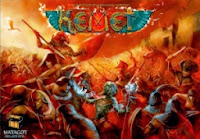In the game
we take control over soldiers in a given colour, and we choose a city to start
in. Each city has three spaces where we may choose to divide our soldiers into
either two or three separate units (consisting of no more than five soldiers
each). When you use the move action, you move the unit as a whole. We are also
given three pyramid tokens (one white, one red, and one blue) that we then
place in separate city chambers.
Gameplay is divided into two phases. In the day phase, players take turns putting down action markers on their individual boards, represented with a pyramid of symbols separated into three different tiers. Players have to take actions belonging to each of the three different tiers in each game round. Actions could be anything from moving a unit of soldiers on the game map, recruiting new soldiers to their troops, upgrading one of their pyramid tokens level (paying the required amount of prayer points), gaining prayer points or purchasing a pyramid action.
When a
player purchases a pyramid action, they may examine the available tiles for the
pyramid in question and choose one that has the same level or lower as the
player's own pyramid token in said colour. All tiles hold some kind of
advantage in the game, and most of the tiles are one of a kind - meaning it's
first come, first served. The white tiles generally give players discounts,
added earnings and so forth. The blue tiles mostly give defensive advantages.
The red tiles mostly give offensive advantages.
Whenever a
player moves their troop onto a space occupied by another player, they will
engage in battle. Players will tally up the number of soldiers in their troop,
then add advantages given by pyramid tiles they have purchased. Then players go
through their battle cards - chooses one they want to play and place it face down
in front of them (along with any divine intervention cards they may want to add
- hidden underneath the battle card) - then chooses another battle card to
discard. Players may not take back any battle cards until they have
participated in three battles. Whichever
player has the greater total attack value wins the battle and gains a
victory point (this can happen even if the player's soldiers are all killed in
battle). The losing player may choose between moving their troop into an
adjacent empty space, or sacrifice their remaining soldiers for prayer points.
In the night phase of the game, players gain
prayer points from the temples they have occupied during the day phase as well as intervention cards,
which mainly help players during battle, but some cards may also help with
other board actions, like making them able to enter another player's city
without pausing at the gate. If a player has any night phase tiles, they get to
play those actions during this phase (in the game I played, I had purchased a
tile that allowed me to increase the level of one of my pyramids for free every
night). Before the phase is over, the player with the least amount of victory
points gets to decide the order which players may take their turns.
The
objective of the game is to get a certain number of victory points, which may
be earned through battle, through occupying temples, through upgrading your
pyramid tokens to the highest level, through purchasing certain pyramid tiles. If
a player has reached this number of victory point by the end of the day phase
of any round, they have won the game (meaning the other players have the chance
to win a victory point from the player before they can declare themselves the
winner).
So, how
newcomer friendly is the game? It's not exactly the first game I'd recommend,
and when you do play it, I really urge you to learn it through a practice round
where players just discuss their play option out loud with one another. There
are a lot of different cards and tiles to keep track off, and you often find
yourself having to clarify the degree a card or tile can affect the outcome.
And it can be a bit confusing how you may move your troops around the board (in
the game I played, the simple misunderstanding I had regarding my own movement
options lead to me missing the opportunity to steal a victory point from a
player that would otherwise be winning the game).
Having a practice round should iron out most of the kinks new players may experience, but still I would recommend having some other strategy type games under your belt before playing this one.
Having a practice round should iron out most of the kinks new players may experience, but still I would recommend having some other strategy type games under your belt before playing this one.


No comments:
Post a Comment